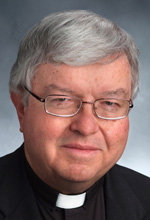Q. When I visit my mother in the town where I grew up, the priest there regularly omits what I think is an important gesture at the beginning of the Gospel reading. He does not use his thumb to sign himself with the cross on his forehead, lips and heart.
I had understood that by making that gesture you were demonstrating your intention to take the Gospel into your mind, proclaim his word to others and keep his message in your heart. Because the priest has foregone that important sign, his parishioners omit it, too. Has this gesture been declared optional now or perhaps dropped altogether? (City and state withheld)
A. The General Instruction of the Roman Missal says in No. 134 that the priest, upon announcing which of the Gospel writers that day’s passage is taken from, then makes “the sign of the cross with his thumb on the book and on the forehead, mouth and breast, which everyone else does as well.”
Note that the wording is ambiguous and could be taken to indicate that each member of the congregation should sign the Gospel book itself, but such has never been the practice and would be impractical.
The congregation signs only their foreheads, mouths and breasts, and there is evidence that they have done this at Masses as far back as the ninth century. The fact that this gesture by the entire assembly was first mentioned specifically in the general instruction only in 2002 would seem to indicate that, far from having been dropped, there is even stronger reason to keep to it today.
As so often happens with Catholics, a ritual gesture reminds us of what our faith calls us to do: in this case, to receive the Gospel with an open mind, to speak it faithfully and to treasure it in our hearts.
Q. It is a common practice of Catholics to request Masses for the deceased. How can the blessings of a Mass help a person who has died and presumably has already been judged? (New York)
A. The custom of Catholics praying for the dead has its origin in Scripture and tradition, which stand as the twin pillars of Catholic faith and practice. First, with Scripture, in the Old Testament’s Second Book of Maccabees in Chapter 12. The Jewish leader Judas Maccabeus prays for his troops who have been slain. (Some of the fallen soldiers have been found wearing pagan amulets taken as booty, which would have violated the law of Deuteronomy, and Judas asks that God forgive their sin.)
The New Testament shows in 2 Timothy 1:18 that Paul prays for a deceased man named Onesiphorus that the Lord “may grant him to find mercy.”
The Catechism of the Catholic Church records in No. 1032 that “from the beginning the church has honored the memory of the dead and offered prayers in suffrage for them, above all the eucharistic sacrifice, so that, thus purified, they may attain the beatific vision of God.” During the days of Roman persecution, the ancient Christians would gather in the catacombs to pray for the dead, and Tertullian in the early third century wrote that once a year, Christians would gather to offer special Masses for their ancestors in the faith.
All of this is based, of course, on the theological doctrines of purgatory and of the communion of saints. In explaining purgatory, the catechism explains in No. 1030 that “all who die in God’s grace and friendship, but still imperfectly purified, are indeed assured of their eternal salvation; but after death they undergo purification, so as to achieve the holiness necessary to enter the joy of heaven.”
The communion of saints describes the spiritual relationship that endures among believers and produces mutual benefit. Those who have already attained heaven pray for us who are still on earth, while we can pray (and offer good works) for those deceased who are still undergoing purification.
What that purification consists of, and how long it lasts, remains a mystery for us while we are still on this near side of eternity; but our prayers and Masses beseech the Lord to speed the process and soften whatever heartache it entails.
***
Questions may be sent to Father Kenneth Doyle at askfatherdoyle@gmail.com and 40 Hopewell St., Albany, N.Y. 12208.
PREVIOUS: Penance recognizes our inadequacy, helps us face future with hope
NEXT: Pope Benedict XVI’s prayer intentions for March




Share this story